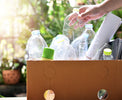
Navigating Plastic Recycling: What You Need to Know
, by Planet Green, 5 min reading time

, by Planet Green, 5 min reading time
Recycling plastics can be a tricky task. With so many types of plastics and different rules for recycling centers, it's easy to get confused. However, understanding which plastics are recyclable and how to prepare them properly can make a significant difference in our efforts to help the planet. A simple understanding of what can and can’t be recycled can help you make better decisions on what you should and shouldn’t opt for in the first place when it comes to choosing packaged items for daily use.
The Impact of Improper Plastic Disposal
Improper disposal of plastics has severe environmental consequences. When plastics aren't recycled, they often end up in landfills or are incinerated, releasing harmful carbon dioxide into the atmosphere. According to NOAA Climate.gov, this contributes to the Earth's rising temperatures. In landfills, plastics can take anywhere from five to 600 years to break down, with plastic bottles taking an average of 450 years and ink cartridges up to 1000 years. It’s astounding how something so small can make such a big impact, and with a million ink cartridges entering landfills every day in the United States alone, you can see how proper disposal and recycling makes a big difference.
Steps to Effective Plastic Recycling
Understanding Recyclable Plastics
Not all plastics are created equal. Many people mistakenly believe all plastics can be recycled, but this isn't the case. The acceptance of different plastics varies by recycling center. To find out which plastics are accepted, contact your local recycling company or check their website. Some bins provided by disposal companies also list acceptable items on the outside.
This is true with ink cartridges more than most anything. You can not dispose of ink cartridges by putting them in the recycling bin. Visit www.planetgreenrecycle.com to get a free shipping label to send your empty and unwanted ink cartridges in to them for proper recycling, every time!

The Reality of Plastic Recycling
Despite our best efforts, less than 10% of plastic is actually recycled, according to rePurpose Global. About 12% is incinerated, and the remaining plastic ends up in landfills or the ocean. This low recycling rate is partly due to contamination from food residue and other materials, which renders recyclable plastics useless. We don’t often consider it, but dirty plastics go into landfills, it’s just the way it is.
Recycling facilities face numerous challenges, such as inadequate machinery to handle the workload. Therefore, ensuring that recyclable plastics are clean and sorted correctly is crucial for improving recycling rates.
Tips for Reducing Plastic Waste
Reducing plastic waste starts with making smarter choices. Here are some actionable steps you can take:
By following simple guidelines and being mindful of your plastic use, you can significantly reduce your environmental impact. Proper recycling, buying recycled and reducing plastic waste are all essential steps toward a more sustainable future we should all be aware of and taking every day.

With November 15th being celebrated as America Recycles Day, the Plastics Industry Association (PLASTICS) commemorates Recycling Week this year from November 11th through November 15th...

Plastic pollution has become one of the most pressing environmental issues of our time, impacting land, waterways, and marine life on a global scale. While...

The rise of online retail has brought convenience to consumers across the globe, allowing for easy access to a wide array of products with a...

As the world grapples with the escalating environmental crisis, the role of major corporations in driving single-use plastic waste has come under scrutiny. From beverage...